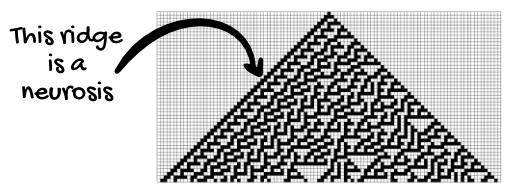"Yeah, but what about all the other laws of physics?" Zac said. "Does this algorithm account for the fine-tuning of the universe?"
"The laws of physics are emergent, Zac. But yes — it accounts for them."
"How?"
"I'll explain that once we venture further down this rabbit hole. It's got a lot to do with rivers, free will, and destiny."
"Destiny? Oh, come on. Tell me now," he pleaded.
"No. I've got more setup to do first. When the time comes, I will explain it using chess."
"You were a chess nerd, weren't you?" Zac said as he threw a rogue grape into the harbor.
"Actually, yes. I haven't played since I was twelve, though. I was never serious enough about it to get good."
"Why'd you quit?" he asked.
"Well, in my last year of primary school, my team won our division in the inter-school chess competition. Then we had our lunchtime competition, and I ended up going head-to-head with my academic arch-nemesis in the finals. I eventually put him in checkmate, then lost interest in the game and quit when I was on top."
"Ah," Zac sighed. "Like a real champion."
"Indeed," I grinned. "Anyway, I'll give you a little teaser as to how our laws of physics are emerging. This passage from The Holographic Universe is not far off. By the way, before this passage, the author gives many examples of mystics and other people who have bent the laws of physics in the same way Jesus appeared to. In particular, he talked about people who could walk through fire unharmed, or hold burning objects against their body without the heat energy damaging their skin."
Just as it is hard to imagine where the deflected energy goes in some of the examples of PK [psychokinesis] we have looked at, it is equally difficult to understand where the energy of a red-hot iron pot goes while the pot is resting against the hair and flesh of a Ceylonese native’s head.
But if consciousness can mediate directly in the implicate order, it becomes a more tractable problem. Again, rather than being due to some undiscovered energy or law of physics (such as some kind of insinuating force field) that operates within the framework of reality, it would result from activity on an even more fundamental level and involve the processes that create both the physical universe and the laws of physics in the first place.
Looked at another way, the ability of consciousness to shift from one entire reality to another suggests that the usually inviolate rule that fire burns human flesh may only be one program in the cosmic computer, but a program that has been repeated so often it has become one of nature’s habits. As has been mentioned, according to the holographic idea, matter is also a kind of habit and is constantly created anew out of the implicate, just as the shape of a fountain is created anew out of the constant flow of water that gives it form. Peat humorously refers to the repetitious nature of this process as one of the universe’s neuroses. “When you have a neurosis you tend to repeat the same pattern in your life, or do the same action, as if there’s a memory built up and the thing is stuck with that,” he says. “I tend to think things like chairs and tables are like that also. They’re a sort of material neurosis, a repetition. But there is something subtler going on, a constant enfolding and unfolding. In this sense, chairs and tables are just habits in this flux, but the flux is the reality, even if we tend only to see the habit.”
Indeed, given that the universe and the laws of physics that govern it are also products of this flux, then they, too, must be viewed as habits. Clearly they are habits that are deeply ingrained in the holomovement, but supernormal talents such as immunity to fire indicate that, despite their seeming constancy, at least some of the rules that govern reality can be suspended. This means the laws of physics are not set in stone, but are more like Shainberg’s vortices, whirlpools of such vast inertial power that they are fixed in the holomovement as our own habits and deeply held convictions are fixed in our thoughts.
Grof’s proposal that altered states of consciousness may be required in order to make such changes in the implicate is also attested to by the frequency with which fire immunity is associated with heightened faith and religious zeal. The pattern that began to take shape in the last chapter continues, and its message becomes increasingly clear — the deeper and more emotionally charged our beliefs, the greater the changes we can make in both our bodies and reality itself.
Michael Talbot
"Think about the laws of physics as emergent features on a cellular automata pattern," I said. "For example, in Wolfram's Rule 30, the black ridge down the side is like a habit that keeps recurring. It's a neurosis in the program, in the same way that individuals have deeply embedded habits in their psyche."

"Let's say I subconsciously play with my hair around men I'm attracted to. If you see me around a man I'm attracted to, you can predict that I'll be playing with my hair. It's a deeply subconscious program running in my psyche. I can, however, consciously change that neurosis — but chances are I won't. That's why it keeps recurring. Change requires firm conviction, and such conviction is abundant in people with 'heightened faith or religious zeal.'
That's why scientists are so lost in the weeds of this problem. They're examining all of this emergent noise — all the particle physics and bosons and fermions and all that minutia — thinking that they can put everything together like a mechanical system. They completely misunderstand the nature of this riddle.
Take dark matter and dark energy, for example. In vague terms, scientists have hypothesized the existence of 'dark energy' to explain a pull towards entropy, and 'dark matter' to explain a push against it. They haven't found evidence of either yet."
"So does dark matter and dark energy exist, then?" Zac asked.
"No idea," I shrugged. "Does anything exist until it is observed?"

